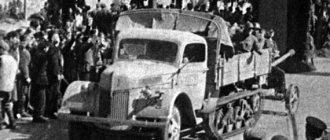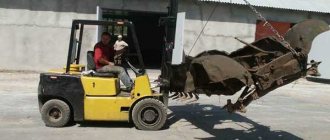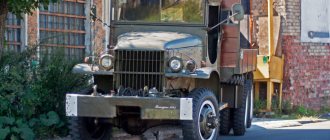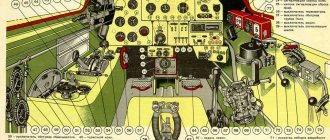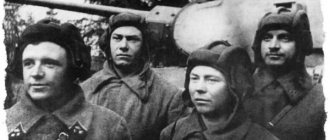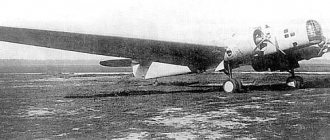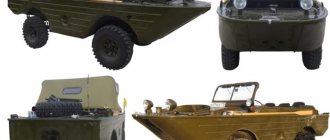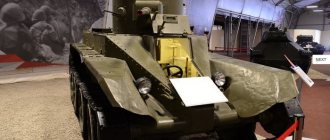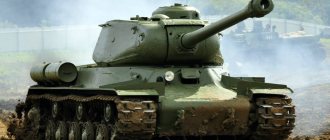About the history of the creation and production of this model
The heavy artillery tractor AT-T was designed and developed in the late 1940s at the Kharkov Machine-Building Plant named after Vyacheslav Malyshev. This work was led by the famous Soviet design engineer who participated in the creation of the legendary T-34 - Alexander Alexandrovich Morozov.
The Malyshev Plant (until 1957 it was called the Comintern Plant) in the post-war years switched from the production of steam locomotives to the production of diesel locomotives, tanks and tracked tractors, as well as diesel engines for widespread use.
In connection with the introduction of the latest artillery and missile systems into service with the Soviet Army, the need arose for heavy tractors to transport them, as well as to transport ammunition for them. The designers were immediately asked to take the new, but already well-tested T-54 medium tank as a basis.
The Main Armored Directorate of the USSR Ministry of Defense directed Morozov and his team to fulfill the following requirements:
- The tractor must tow artillery and missile systems and trailers weighing up to 25 tons: 203-mm B-4 howitzer, 130-mm KS-30 anti-aircraft gun, other high-power guns, 8K63 missile systems;
- He must be able to move with a full load at a speed of 35 kilometers per hour;
- The tractor must operate successfully in any climatic zone of the Soviet Union;
- The load capacity of its cargo platform must be at least 5 tons;
- There must be a winch with a traction force of at least 25 tons;
- The tractor chassis must be able to mount on it all kinds of special equipment for various branches of the military and special forces of the Soviet Army, with trouble-free operation;
- The tractor should be applicable not only in military, but also in civilian industries.
Of course, all these requirements were met, and already at the end of 1947, the first prototypes of the new heavy artillery tractor were produced at the Kharkov Machine-Building Plant.
To test them, a test run was made along the route Kharkov - Moscow (Kubinka). During this run, “product-401” proved itself to be a good tractor - as a tractor quite powerful, durable, maneuverable, efficient, with excellent traction properties; convenient to use and easy for field repairs.
After comparative tests and compilation of a set of indicators into one table, the AT-T turned out to be the most progressive among all other models of heavy artillery tractors of the 1st post-war generation. The creators of “product-401” were awarded the Stalin Prize in 1948.
Since 1950, mass serial production of these heavy tractors began. And at the end of 1958, a particularly severe test awaited them: as part of the 4th Soviet Antarctic Expedition, the tractors were delivered to Antarctica. On January 10, 1959, a column of tracked all-terrain vehicles left Mirny and began regular work in Antarctica.
On December 26, 1959, a caravan of an AT-T tractor and two “Kharkovchanok” (a polar special vehicle made on its basis) reached the extreme tip of the globe - the South Pole. In No. 3 of the popular magazine “Technology for Youth” for 1959, these tractors were placed on the cover, with the caption “Snow Ships”.
It was the first post-war high-speed heavy tracked tractor, designed for towing trailers (artillery systems) weighing up to 25,000 kg, which found wide use in the Soviet Armed Forces. The AT-T tractor continues to serve today in units of the Russian army, helping geologists, gas workers and oil workers in Siberia and the Far North live and work.
Wheels, tracks and two engines: forgotten Soviet experimental AT tractors
Artillery tractors became an important means of motorization of the Red Army
Artillery tracked satellites
In preparation for the big war, the leaders of the Red Army understood that the army needed strong artillery: the number of guns and mortars of all types and calibers from 1934 to 1941 increased from 15,059 to 110,444 units. This is more than the Wehrmacht had at the time of the attack on the USSR.
Crawler tractor S-2 "Stalinets-2"
The situation was noticeably worse with the means of transporting weapon systems. Until the early 1930s, horse traction was used in this capacity. The situation was radically changed by the resolution of the Revolutionary Military Council of the USSR “On the transition of the Red Army artillery to mechanized traction,” adopted in May 1932.
Over the following years, they mastered the production and adopted a series of tracked tractors of various traction classes for the Red Army. Thus, “Komsomolets” could tow trailer systems weighing 2 tons, STZ-5 – 4.5 tons, “Comintern” – 12 tons, S-2 “Stalinets-2” – 10 tons, “Voroshilovets” – 18 tons. Together with them, the arsenals of the Red Army were replenished with agricultural tractors, which served as artillery tractors. The traction capabilities of such models STZ-3 (SKHTZ-NATI), ChTZ S-65, Kommunar and ChTZ S-60 ranged from 2.6 to 5.5 tons. True, these vehicles were seriously inferior in reliability and speed to special tracked military vehicles.
The Comintern tractor could move on almost any off-road terrain
In June 1941, the Red Army had 44.9 thousand tractors and tractors, among which special army vehicles (Komsomolets, Komintern, Voroshilovets) accounted for slightly more than 10 thousand - 20.5%, of which the artillery were 26%, and transport vehicles (Kommunar, STZ-5, S-2 Stalinets-2) occupied no more than 15% of the total. The remaining 64.5% were agricultural tractors - ChTZ S-60, ChTZ S-65 and STZ-Z.
The most powerful pre-war tracked tractor "Voroshilovets"
The greatest concern was caused by the segment of army artillery tractors, where even with the massive use of civilian tractors, the army had only 27 thousand instead of the required 31.5 thousand. Moreover, most of them are agricultural tractors and low-power Komsomolets. That is why the artillery’s need for special tractors before the start of the war was at the level of 20%. Those in greatest deficit were STZ-5, Cominterns, S-2 Stalinets-2 and Voroshilovtsy.
A logical question arises: why did the army develop a shortage of powerful tractors by 1941? The answer is simple: priority was given to tank units, and artillery units were equipped with the necessary equipment secondarily.
Here is what the People's Commissar of Defense S.K. Timoshenko wrote about this to the Chairman of the Defense Committee under the Council of People's Commissars of the USSR K.E. Voroshilov in December 1940: “ The main reasons for the extremely difficult situation with mechanical traction means in artillery units are: a) the lack of special factories for the production of artillery tractors, and the conversion of agricultural-type tractors into artillery ones at existing tractor factories does not give positive results; b) the absence of special design bureaus for the development of artillery tractors, as a result of which the design and research work on the creation of artillery tractors occurs spontaneously and is not led by anyone; c) the discrepancy between the agricultural tractors supplied to artillery units, both quantitatively and qualitatively.”
S-65 "Stalinets" tractors, which were used as artillery tractors
The understaffing of the towing fleet in the army, the often discrepancy between the actual capabilities of the tractors and the characteristics of the towed guns, and finally, the rapid advance of the Wehrmacht deep into the country led to the fact that during the summer retreat the Red Army lost about two thousand guns of 122, 152 and 203 mm caliber. Most of the remaining vehicles were urgently sent to the rear in order to save them from destruction and not to aggravate the existing shortage. They were almost never used in combat until the counter-offensive operation near Moscow.
At the initial period of the war, the Red Army lost a large number of artillery tractors
Heir to the Comintern
The situation on the fronts was changing, the Red Army went from retreat to counterattack. By the summer military campaign of 1942, powerful tractors with high traction qualities were needed to transport specially powerful artillery systems at the disposal of the Reserve of the Supreme High Command - otherwise it was simply impossible to carry out an offensive.
However, the remaining pre-war vehicles such as “Comintern”, S-2 “Stalinets-2” and “Voroshilovets”, the production of which had been discontinued, were clearly not enough. All these tractors were civilian. With a certain degree of convention, they were created as dual-purpose vehicles, but in military conditions their components and assemblies worked under extreme loads, breakdowns were frequent, and constant problems arose with spare parts.
First of all, a relatively compact tractor was needed, capable of towing up to 9 tons. The performers were found quickly. They became ZIS and the Scientific Research Tractor Institute (NATI), which had previously worked in tandem to create army half-track tractors ZIS-42 and ZIS-42M. An incredibly short period of time was allotted for everything (development and mass production) - three months. It seemed possible to complete this extremely complex task only by using products from existing production. And if so, they decided to select the engine, transmission and front axle from the ZIS nomenclature, and unify the chassis with the T-70B light tank.
For the new half-track tractor, one of the aggregate donors was the three-ton ZIS-5V
There was also a reason for choosing the half-track design of the tractor, which received the designation AT-8 (the index is given based on the mass of the towed systems). A vehicle of this type is stable on the road, does not sway and allows the installation of special superstructures, the design manages to fully use automotive parts and transmission units, the hood layout with the engine located above the front axle provides large body dimensions and makes the tractor more versatile. In addition, the steered wheels do not destroy the road surface when cornering.
They decided to borrow many elements of the chassis for the AT-8 from the T-70B light tank
The main problem was the lack of a serial engine for the AT-8 with an estimated power of at least 150-160 hp. For this reason, NATI engineers, when designing their version of the tractor, were not able to use the in-line 6-cylinder overhead valve engine MB-27 (10.3 l) with a power of 155 hp, developed at the institute before the war. and a three-speed manual gearbox paired with it. These units remained experimental, although they performed well on the experimental NATI-A city bus.
Motor hunger forced NATI specialists, when developing the second version, to focus on a pair of ZIS-5 (ZIS-16) engines, kinematically connected to each other using a sequential summing gearbox, main clutch and gearbox. Unfortunately, the mentioned transmission units were also not mass-produced, which decided the fate of the project.
Adhering to the twin-engine layout, the engineers of the ZIS Design and Experimental Department took a different path. The team, headed by Boris Fitterman, relied on a proven and industry-proven component base, primarily the engine. The choice fell on the ZIS-16 in-line six (5.55 l), the power of which was increased to 90-92 hp and the torque to 30 kgf m. The engine was boosted due to the fact that cast iron pistons were replaced with analogues made of aluminum alloy, a cylinder head with a new combustion chamber was used, increasing the compression ratio from 4.6 to 5.7, the valve lift was increased to 10 mm, using new pushers and a modified camshaft. designs with wider valve timing, spark plugs were placed above the exhaust valves. The engine was equipped with a 12 V generator (ZIS-5 has 6 V), and its assembly was carried out with individual selection of parts and scraping of the main and connecting rod bearings. At the same time, the engine was equipped with a standard clutch and a four-speed manual gearbox from the ZIS-5.
When creating the AT-8, the experience of working on the YAG-NATI-2M twin-engine truck came in handy
Here, the experience of designing an experimental twin-engine truck YAG-NATI-2M (6x4), in which B. Fitterman also took part, came in handy. The vehicle, built in 1933, was equipped with two AMO-3 engines and two transmissions, each of which transmitted power to its own drive axle using a Brown Lipe 35 gearbox and a NATI-designed range-shifter. A common lever was used to control both gearboxes.
Parallel arrangement of engines on YAG-NATI-2M under a single hood
A similar scheme without a rigid mechanical connection between the tracks was used on the AT-8. The engines are placed on a supporting frame welded from two longitudinal channels, cross members and reinforcements, at a distance of 660 mm from each other. Torque was transmitted to the drive axle, made in the form of a cast crankcase with two ZIS-5 main gears installed inside, through gearboxes and cardan shafts. At the same time, synchronous control of both gearboxes was provided by a single lever. The tracks were directly driven by axle shafts topped with drive wheels from the T-70B tank.
AT-8 twin-engine half-track tractor
A special lever differential mechanism that acted on the engine throttle valves was responsible for synchronizing the operation of the engines. Stability of movement in a straight line was ensured by steered wheels. When turning, the corresponding (internal) motor reduced power and speed, and the external one proportionally increased these parameters, and the process occurred automatically using an ingenious vacuum device connected to the steering mechanism. The control of clutches, gearboxes and accelerators has been duplicated. The confident movement of the AT-8 on soils with low bearing capacity (snow, swamp, muddy road) was facilitated by a differential-free transmission with a rigid kinematic connection between all its elements.
The car felt confident on rough terrain
To facilitate turning, the transmission belt brakes (with foot and manual control), mounted on the shanks of the main gears, were applied separately to the right and left sides.
Without a trailer, the tractor climbed a slope of 34°
The front axle was equipped with dependent suspension on semi-elliptic springs and oversized tires with developed lugs. In addition to the lantern drive wheels with removable gear rims from the T-70B tank, the tractor received sloths equipped with a track tensioning mechanism, and four single-pitch road wheels (on each side) with a diameter of 550 mm with rubber tires, unified with them. The upper branch of the small-link caterpillar, 300 mm wide, rested on three small support rollers on each side. Suspension: individual torsion bar without shock absorbers. This design provided the car with a good smooth ride on the roads.
Movement along the slope
The unique flavor of the car was given by a two-seater wooden cabin from the ZIS-5V of increased width, a massive hood with folding side flaps that covered both engines, a simplified tail and a front bumper made of channel wood. Immediately behind the cabin there were gas tanks, and next was a wooden side platform with an area of 4.5 m2 with a folding tailgate, which could accommodate 2.5 tons of cargo or 15 people. The curb weight of the tractor without cargo and fuel was 7 tons, width - 2550 mm, length - about 6.5 m, minimum ground clearance (under the steering axle beam) - 380 mm. The load on the front axle (without/with load) is 1.9/2 tons, on tracked vehicles, respectively—4.8/7.5 tons.
To understand the difference, it makes sense to compare the performance characteristics of the AT-8 with the pre-war Stalinets-2 tractor, which is similar in characteristics. The weight of the latter in running order without cargo is 11.94 tons, the load capacity of the platform is 1.5 tons (8 seats in the body), the weight of the towed trailer is 10 tons. You can compare the AT-8 with the Comintern. That one had a towed trailer weight of 12 tons, and a curb weight of 10.64 tons.
In general, the main thing that distinguished the AT-8 from its predecessors was its significantly lower weight and, moreover, greater payload capacity.
Overcoming the scarp
A prototype AT-8 was designed and built during October-December 1942. The vehicle was tested in the spring and summer of 1943. From the very beginning, the tractor demonstrated impressive results, which indicated the correctness of the solutions incorporated into its design.
AT-8 towing an ML-20 gun-howitzer with a caliber of 152 mm
With the ML-20, the tractor could move on muddy ground
Towing an artillery system weighing 9 tons, the AT-8 with 2.5 tons of cargo in the back confidently moved on all types of roads and off-road. The maximum speed with a full load reached 28 km/h, the average speed when driving on the highway was 20-21 km/h. The greatest climbable climb with a 9-ton trailer was 20°, without a trailer – 34°. The car could move along a 30-degree slope. The average specific pressure of a caterpillar propulsion unit without a load is 0.36 kgf/cm2, with a load – 0.47 kgf/cm2. On the highway, the fuel consumption of a train weighing 18.5 tons was around 160 l/100 km or 1.2 kg per km of track.
Transportation of a 203-mm howitzer B-4 with a dismantled barrel
Some shortcomings were also discovered. Among them are insufficient traction force on soils with a low coefficient of adhesion, rather low strength of the supporting frame and axle shafts, and in extreme operating conditions there have been cases of gearbox failure.
The traction capabilities of the AT-8 made it possible to create a new, more advanced vehicle
At the same time, the tests revealed a large reserve of power, which gave grounds to continue work on an improved version of the tractor, designed to work with trailed systems weighing 13-14 tons.
Older brother
Having received feedback (and, by and large, a refusal to take the vehicle into service), the factory workers actively began developing a new tractor with the AT-14 index, completing design work at the end of the summer of 1943. The index was again assigned based on the mass of the towed system. Already in the fall, two cars were produced. On each of them, the strength of the frame and axle shafts was increased, gearbox failures were eliminated by equipping the transmission with range-shifters from a Studebaker US6 all-wheel drive truck, which at the same time expanded the power range of the transmission. To simplify control, transmission belt brakes began to act simultaneously on both sides. Now they did not need separate controls to make turning easier. Thanks to an increase in the difference in rotation speeds of the engine crankshafts, the minimum turning radius (on the inside of the track) was reduced to 6.3 m.
The main difference of the AT-14 tractor was the extended tracked propulsion unit
To improve driving performance, each tracked propulsion unit received a fifth road wheel, and the tracks received rubber shoes. This led to an increase in the supporting surface area. Due to the fact that the front part of the track was moved closer to the steered axle, the overall length of the tractor did not increase. Three gas tanks with a total capacity of 315 liters with separate fuel supply to the engines were moved to the front part of the body, which was moved close to the rear wall of the cabin. The fastening of the towing device from the rear cross member of the frame was transferred to an elastic element in the form of a spring, which, when towing trailers, reduced dynamic loads, especially when starting and braking. A place was found for the spare wheel on board the cargo platform. Loads and people in the back could be protected from bad weather by removable arches and an awning. Other components of the design have remained virtually unchanged. After modernization, the curb weight of the vehicle increased to 8 tons.
The new tractor now has a spare wheel, which is mounted on the side of the body
In the winter of 1944 at the factory, and in the spring and summer at the testing grounds, the AT-14 was subjected to extensive testing. The obtained characteristics turned out to be quite convincing. The thrust on the hook when driving on snow reached 3.9 tons, on the ground - 7.5 tons, on asphalt - 6.2 tons. On the highway, the car, towing a 14-ton trailer, accelerated to 25 km/h, the average speed was 18 km/h, and on a country road – 8-12 km/h. The car’s assets include overcoming 14-degree inclines and fords up to 0.8 m deep. With a load in the back, but without a trailer, it was possible to conquer inclines of up to 30°. The average specific pressure of the caterpillar propulsion system of a vehicle with a load in the back was around 0.5 kgf/cm2. Cruising range with full load is 225 km.
Another advantage of the chosen layout scheme was that a tractor with one running engine could move on a highway with a trailer without much effort, and without it on a country road. In a combat situation, the failure of one engine did not lead to the vehicle stopping with all the ensuing consequences.
Layout of AT-14 and its overall dimensions
In the fall of 1944, state tests of the AT-14 were completed in the Moscow region, which showed that the tractor complied with the tactical and technical requirements of the Red Army. The vehicle, as expected, could not only work reliably with artillery systems weighing up to 14 tons, but also, if necessary, up to 19-20 tons. These factors, despite the somewhat massive size of the tractor, the not very high reliability of a number of elements and the absence of a winch, became decisive for military experts. As a result, the Main Logistics Directorate of the Red Army expressed serious interest in the AT-14 as a transporter of heavy artillery systems.
AT-14 was distinguished by its relative simplicity of design
Encouraged by this outcome, ZIS began manufacturing a batch of eight tractors. But the joy turned out to be premature. Back in 1943, high-speed tracked tractors HD-7-W and HD-10-W from the American company Allis-Chalmers began to arrive under Lend-Lease (over 2.5 thousand units were delivered). The first model could tow artillery systems weighing up to 8 tons, the second - up to 14 tons. These were also agricultural vehicles, but the key difference between them and ZIS ATs was the presence of two-stroke diesel engines from GM - a 3-cylinder 3.5-liter on the “seven” and a 4-cylinder 4.7-liter on the “ten”. Another important advantage was the presence of a winch with a traction force of up to 21 tons - the AT-8 and AT-14 did not have it.
For use in military conditions, both of these tractors had additional protection, but not from bullets and shrapnel, but from collisions with obstacles. American tractors performed relatively well, although some of the disadvantages include an open cabin and demanding fuel quality. The average speeds of these machines ranged from 5 to 10 km/h, that is, they were approximately 2 times higher than those of the Stalinets tractors. At the same time, the maximum towing speed of the 122 mm cannon of the 1931/37 model and the 152 mm howitzer-gun of the 1937 model of the AT-14 reached 25 km/h.
It was not only Lend-Lease deliveries that prevented the adoption of ZIS tractors. Since 1943, YAZ began producing the YA-12 tracked tractor, capable of transporting 8-ton trailers. The Yaroslavl car was also diesel, with the same engine as the Allis-Chalmers HD-7-W. In addition to these three vehicles, a dozen different models of American tractors were supplied from Caterpillar, International and the same Allis-Chalmers, but all of them were not so widely used in the artillery units of the Red Army.
Considering this generally successful experience and the fact that the war was nearing its end, they did not invest in the production of a twin-engine tractor from the ZIS. The matter never came to the combat use of the AT-8 and AT-14.
American tractor Allis-Chalmers HD-10-W, which, together with the HD-7-W, played a fatal role in the fate of the ZIS tractor
At this point, it would seem, the topic of twin-engine cars with an onboard non-differential type of transmission has been exhausted. But no. According to the same scheme, in the 1950-1960s, several promising off-road vehicles were created at ZIL at SKB V. A. Grachev, some of which were produced at the Bryansk Automobile Plant for quite a long time. So the seemingly dead-end idea received its creative development.
The twin-engine ZIL (BAZ)-135LM with an onboard differential-free transmission is still in service with the Russian army
About the chief designer and manufacturer
Alexander Morozov's whole life was connected with his native enterprise. He began working at the Kharkov Locomotive Plant after the 6th grade of school, in 1919. In 1930, he graduated from the Moscow Automotive and Tractor Institute named after Lomonosov, which has now become the Moscow State Technical University "Moscow Automechanical Institute". At the end of the 1930s, he was on the design team that created the most massive production tank of the Great Patriotic War, our “Weapon of Victory” - the T-34.
Throughout the war years, he served as chief designer of the Kharkov plant, which was evacuated to the Urals in October 1941. From November 1951 he became the chief designer of the Kharkov Mechanical Engineering Design Bureau, and in 1966-1976. was his boss. Under his leadership, the T-64 (in 1963) and T-64A (in 1966) tanks were developed.
Since June 1976, Morozov became a consultant to the Kharkov Design Bureau of Mechanical Engineering and a member of the Scientific and Technical Council of the USSR Ministry of Mechanical Engineering. He passed away in 1979, at the age of 74.
After the war, the Kharkov Machine-Building Plant named after Malyshev produced tanks T-44, T-54, T-55 up to 14 different upgrades, T-64, T-80, T-80U, T-80UD. Moreover, the plant’s productivity record was set not in the prosperous Soviet years, but in the fatal year 1991 for the USSR - 800 tanks per year (at that time, especially many T-80UDs were sold for export). But after the record year of 1991, the plant never even came close to such indicators.
In 1995, on the basis of the T-80UD, the main Ukrainian tank T-84 was developed (modifications - T-84BM "Oplot" and T-84-120 "Yatagan". The largest contracts of the enterprise in the history of independent Ukraine were the sale of 320 T-80UD tanks to Pakistan (concluded in 1996); Thailand - 49 Oplot tanks and 121 BTR-3E1 (2011); Iraq - 420 BTR-4 (2009).
In the front part of the tractor under the cabin, a 12-cylinder liquid-cooled V-401 diesel engine with a power of 305 kW (415 hp) at 1600 rpm is installed longitudinally with the flywheel forward, allowing it to travel along the highway at full load with a maximum speed of 35.5 km/ h.
Non-intended use: Firefighter armor
SLS-100 "Jay" in Balashikha. Photo: doroshenko-us.livejournal.com
Humanitarian mission of the tank
When a tank becomes part of the fire service, there are several reasons for this.
Firstly, tracked vehicles are often indispensable in the fight against forest fires due to their maneuverability and the ability to deliver the extinguishing mixture directly to the fire front. The ignition temperature of rubber does not allow wheeled vehicles to clear away burning rubble and get close to the flames.
Secondly, the armor protects not only from extreme temperatures, but also from fragments and even from direct hits from shells when artillery depots catch fire. That is why firefighting tanks first appeared among the military.
GPM-54. Source: fireman.club
In the Soviet Union, the Lvov Armored Plant (17th Repair Plant) was responsible for the production of armored vehicles for firefighters, which to this day converts tanks into fire trucks.
The first order for unusual tracked vehicles came to Lviv in 1978 from the Main Rocket and Artillery Directorate of the USSR Ministry of Defense. By that time, production documentation for the fire tank had been developed and prepared by engineers of the Kyiv 482nd CTC of the USSR Ministry of Defense.
Please note that it was not the tank crews who needed fire armor, but the artillerymen. This is largely due to Siberian ammunition depots, which regularly suffer from forest fires.
For some time, artillerymen made do with homemade weapons based on decommissioned T-34s, but by the 70s this equipment was obsolete. The military presented serious demands to the developers - at least 10 tons of water on board, 2 tons of foaming agent and the presence of a monitor with a water supply capacity of 40 liters per second.
GPM-54. Source: armor.kiev.uaThe T-54 was chosen as the platform, from which the turret was removed and a giant tank was installed. Fortunately, by that time there were many tanks decommissioned from service. The new product was given the appropriate name - GPM-54 (tracked fire engine).
The first tests showed that the T-54 is not the best suited for the role of a firefighter, largely due to its large mass. The huge fuel consumption reduced the operating time of the fire tank, and the problem was solved by replacing the projectile armor with 20-mm steel sheets.
However, even in the de-armored state, the vehicle's curb weight was excessive - it had to be reduced to 43 tons by reducing the supply of transported water to 9 tons.
The crew consisted of two people: a driver and a fire nozzle operator, who also served as a tank commander. The key disadvantage of the GPM-54 was the gear drive of the water pump, which did not allow the machine to simultaneously move and pour fire extinguishing mixture onto the flames.
The procedure for servicing the power plant also added complications. A body with tanks rising on hydraulic cylinders was placed directly above the tank diesel engine. Despite the fairly powerful pump, the firefighters did not have enough water supply speed. In order to extinguish the flaming stacks of ammunition, a high intensity of water flow was required. The range of the fire nozzle was about 60 meters, but the GPM-54 crew nevertheless had to get within 10 meters of the flame - only then was the fire extinguishing efficiency sufficient.
First of all, diesel engines suffered from the extreme heat, failing due to overheating. The fire intensively burned oxygen in the area, abundantly saturated the air with combustion products, which also caused the engines to stop. A fire tank stalled in front of a burning arsenal is almost certainly a mass grave. The temperature around GPM-54 did not even allow the crew to get out of the car. Unfortunately, such tragedies have happened...
GPM-54. Source: armor.kiev.uaThe Lviv fire tank coped best with forest fires - for this it had a bulldozer blade. GPM-54 was capable of making passages and clearing burning rubble. In 2005, the Ukrainian tank was modernized, adding the index 01 and new bulldozer equipment TBS-86. Another seat was added to the cockpit - the duties of the fire nozzle operator could be removed from the vehicle commander.
The experience of extinguishing fires at arsenals in the 70s and 80s showed new vectors for the development of technology for such extreme conditions.
Firstly, it is very desirable to have a much larger one-time mass of “water shot” or at least a supply of fire extinguishing mixture.
Secondly, high temperatures require remote control systems for fire tanks.
"Jay" and others
The next hero of the story will be a tracked vehicle with a long name - the robotic self-propelled monitor SLS-100 “Soyka”.
The fire bird appeared in response to the Chernobyl accident, but numerous difficulties made it possible to assemble the first prototype only by the end of the 90s. The basis for the SLS-100 was the T-54/55, equipped with a remote control system and capable of operating near sources of radioactive and chemical contamination. When conditions permitted, the self-propelled carriage operated under the control of a two-man crew inside an armored hull.
SLS-100 "Jay". Source: fireman.club
There was no need to lighten the Soyka - the armor absorbed ionizing radiation quite effectively.
The self-propelled fire monitor did not have a water supply on board, but pulled a 100-meter fire hose behind it.
Developers from the All-Russian Order of the Badge of Honor Institute of Fire Defense (VNIIPO) and OKB PO Pozhmashina took into account the errors of the GPM-54 tank and equipped the Soyka with a more powerful pump. Now water can be supplied to the fireplace at a distance of 100 meters, and foam - from 70 meters.
By the way, “Jay” is installed on a pedestal near the main entrance of VNIIPO in Balashikha near Moscow. The production of self-propelled carriages in small series was established at the 61st repair plant in Petrodvorets.
The issue of remote control of fire tanks was resolved only in the late 90s. The problem of the volume of a fire extinguishing salvo was overcome much earlier - in 1988 with the advent of the unique Impulse-2M vehicle. Experimental work in this area received the characteristic name of the development work “Braking”, and the tracked vehicle itself at the final stage of development was designated as “product 054”.
The first experiments were carried out on the well-deserved T-55 chassis under the name “Impulse-1”. The firefighting tank, which later became a serial one, was assigned a T-62 tank leaving the army and placed on the roof... a multiple launch rocket system! If you do not take into account the characteristic color of the car, then “Impulse - 2M” can easily be confused with TOS “Buratino”.
The so-called multi-barrel module consists of 50 barrels, from which you can fire anything - liquids, gels, sand or powders, in general, anything that does not support combustion. It is worth noting that the fire tank did not launch rocket-propelled grenades, but rather fired at the source of the fire, as if from a cannon.
The T-62 platform allowed the vehicle to withstand the recoil of five consecutive salvoes from ten barrels. If the operator mistakenly cocked more than ten barrels, the automation blocked the salvo.
An important feature of the new fire tank was the system for spraying the armor with water or other insulating substances - the sad experience of the burnt GPM-54 was not in vain.
"Impulse-2M". Source: mpulse-storm.com
"Impulse-2M". Source: vpk.name
The mechanics of putting out burning artillery dumps were not complicated.
Unlike its predecessor GPM-54, the Impulse did not need to approach the fire at a distance of 10 meters - 70-100 meters was enough. Next, the operator aimed the launch module with 200 mm barrels and fired a single shot or a salvo at once. The flame was extinguished by the thrown substance (water, sand, and so on), and also knocked down by the shock wave, blocked by the products of the explosion and crushed into small, not so dangerous, foci.
Up to 30 kg of substance could be stuffed into each Impulse-2M barrel. This was real Soviet know-how, the author of which was Vladimir Dmitrievich Zakhmatov, a junior researcher at the Department of Explosion Geodynamics of the Institute of Geophysics of the National Academy of Sciences of Ukraine. The scientist not only proposed to extinguish the fire with an explosion, but also successfully tested his fire extinguishing bombs in Chernobyl in 1986.
The fire tank demonstrated impressive performance in practice.
For example, once the developers filled a 30-meter ravine 2 meters deep with rubber tires, filled everything with a ton of diesel fuel and 150 liters of gasoline. They set it on fire and sent the crew on the Impulse-2M to investigate. The tank suppressed fire with eight salvoes from 10 guns from a distance of 10 meters.
To be continued…
AT-T heavy tractor engine
The AT-T has a diesel engine, reliable, unpretentious, model A-401. Its prototype is a modification of the well-proven tank diesel engine type V-2, which was equipped in pre-war and wartime with both medium and heavy Soviet tanks - T-34, KV and IS. Tank engines of that period were characterized by a limited resource - 250 machine-hours before overhaul, because the piston group was subject to high abrasive wear under operating conditions with significant dustiness. If the dust content was at a low level, the engine life increased several times.
A-401 is a V-shaped 12-cylinder 48-valve four-stroke high-speed liquid-cooled diesel tank engine with direct injection. The working volume of this engine is 38.8 liters, the compression ratio is 14…15. The rated power of the A-401 engine is 331 kW, or 450 horsepower at 1750 rpm, and the operating power is 294 kW, or 400 hp. s., at 1700 rpm.
The average specific diesel fuel consumption of this engine is 230 g. / kWh (170 gr. / hp h). The engine has a duplicate start - using an electric starter with a power of 11 kW (15 hp), or compressed air (backup system). To facilitate starting at low air temperatures, a nozzle-type heating boiler is installed.
AT-T heavy artillery tractor. TTX. Dimensions. Engine. Story
During World War II, the Kharkov Locomotive Plant (KhPZ) worked on the creation of artillery tractors based on the T-34 tank. The result of the work was the AT-42 and AT-45. After the war ended, completely new heavy artillery systems entered service with the Soviet Army, which required corresponding tractors. Work has resumed at KhPZ. In 1946, production of the T-54 tank began, and on its basis, the designers developed a new tractor, serial production of which began in 1953. This vehicle received the AT-T index (heavy artillery tractor) and very soon gained recognition, as evidenced by its release in the 50s. in large quantities and in various modifications.
AT-T transmission
The mechanical transmission of this heavy tractor includes a multi-disc main dry friction clutch, a five-speed gearbox with synchronizers in the 3rd, 4th and 5th gears and a power take-off to the winch, two two-stage planetary turning mechanisms and two single-stage final drives. The use of two-stage planetary turning mechanisms greatly facilitates the control of a heavy special vehicle when maneuvering and ensures a minimum turning radius in place, which is equal to the vehicle track width - 2.64 meters.
Suspension and chassis
The caterpillar propulsion system of the AT-T heavy tractor is five-roller, on each side. It consists of a small-link caterpillar chain of lantern engagement with an open hinge, five double track rollers of significant diameter - 830 mm, with external shock absorption made in the form of rubber bands, a rear guide wheel with a crank mechanism for tensioning the tracks and a front drive wheel with removable gear rims .
The caterpillar chain consists of 93 tracks with guide ridges 500 mm wide, with developed lugs, which makes it possible to attach additional lugs (spurs) to them for movement in deep snow, mud and sand. The tracks are made of wear-resistant steel LG-13 and have good abrasion resistance. The fingers and connecting tracks are fixed with a head and at the ends with riveting. The resource of the caterpillar chain is approximately 6 thousand kilometers.
The tractor suspension is independent torsion bar; The location of the torsion shafts above the bottom of the body is transverse. Shock absorbers were not installed on the front and rear suspension units. The suspension of the tractor provides the ability to travel on dirt roads and highways with a specified maximum speed of 20 and 35 km/h. respectively.
Floating tracked conveyor-tractor GT-T
The tracked transporter tractor, also known under the designation “Product 21,” was created in the USSR in the late 1950s and was widely used in the Soviet Army and in the national economy. The start of serial production of the GT-T was the reason for the cessation of development in the Soviet Union of a number of wheeled all-terrain vehicles (for example, ZIL-E167). The creation of such a universal vehicle, with excellent cross-country ability and the ability to swim, brought Soviet mechanical engineering to a new level. More than half a century later, GT-T all-terrain vehicles, various modifications and upgrades of this vehicle are still suitable for use and are in demand on the Russian market. This technique is widely used in various fields of production, especially in the Far North.
The idea of creating a new floating tracked tractor-transporter was approached in the USSR in the late 1950s. In 1958-1960, the machine was developed by designers of the Kharkov Tractor Plant. The model was designated “product 21”; its production was planned to be launched at the newly built Rubtsovsk Machine-Building Plant (today a branch of the Uralvagonzavod Research and Production Corporation). The first two transporter bodies were built at the new enterprise at the end of 1961. In March 1962, the main conveyor for their assembly was successfully put into operation, and the first two products were assembled and delivered. Throughout 1962, an additional pilot batch of five vehicles was produced. The following year, the production volume of GT-T transporters was already 10 vehicles per month, and by the end of 1966 it reached a stable figure of 110-120 all-terrain vehicles per month.
In 1968, a branch of RMZ was organized for the production of GT-T floating all-terrain vehicles in Semipalatinsk, and since 1977, the production of these vehicles, of which more than 10 thousand pieces were assembled, was finally transferred to the branch. In the period from 1983 to the early 1990s, about 600-700 GT-T tracked transporter tractors were assembled and sold annually in Semipalatinsk. In the 1990s, work was carried out to modernize the vehicle, in particular, the V-6A diesel engine was replaced with more advanced and powerful Yaroslavl YaMZ-238 engines. The engine compartment was moved to the middle part of the tractor, which made it possible to achieve a more even weight distribution of the vehicle. Rollers with the most wear-resistant polyurethane coating were also developed.
GT-T in the Museum of Military Equipment "Military Glory of the Urals"
Design of the GT-T
The tracked heavy conveyor-tractor is a high-speed, cross-country vehicle, capable of floating, with a load-bearing body and front drive wheels. This transporter-tractor with an independent torsion bar suspension is designed for transporting people and various cargoes off-road in wooded, swampy areas and snow-covered virgin lands in the Far North and Arctic regions with simultaneous towing of special wheeled ski trailers or other systems with a total weight of no more than 4 tons The carrying capacity of the conveyor itself is 2 tons or 23 people, the crew is 2 people. The movement of the conveyor on the water was ensured by a caterpillar propulsion unit. To increase the speed of the conveyor afloat when overcoming various water obstacles, quick-release hydrodynamic flaps can be installed on the front fenders of the GT-T hull.
The GT-T conveyor was equipped with water pumping equipment, which consisted of a mechanical centrifugal pump and a manual piston pump. The standard set of spare parts for this all-terrain vehicle was supplemented with means for increasing cross-country ability. For example, to improve the adhesion of the conveyor tracks to the ground, additional lugs could be used, and for self-extrication when stuck, special chains and a “legendary” log, without which it is difficult to imagine models of Soviet armored vehicles today, could be used.
Operation of this vehicle in off-road conditions, very rough terrain with little vegetation and deep water barriers did not cause any complaints. In winter, the conveyor-tractor could be used at extremely low ambient temperatures. Due to its qualities, the GT-T was widely used in the Soviet Army until the collapse of the USSR. In addition to the army, the car was also in demand by the national economy. The GT-T tracked transporter tractor fully managed to share the glory of the pioneers of the development of the North, who, with the help of this machine, successfully passed through virgin forests and unsteady peat bogs (mari).
The supporting body of the heavy tracked conveyor-tractor was all-metal, of a welded frame structure. The base of the body was sealed, the body was open. The body of the all-terrain vehicle was divided into three compartments: engine and transmission, cabin and body. In the front part there was a MTO, which was separated from the cabin by special partitions and guards for the engine located in the center of the cabin. To the left of the engine was the GT-T driver's seat with chassis controls. In the middle part of the all-terrain vehicle body there was a four-seater cabin, and in the aft there was a body. The body and cabin were not separated from each other. The top of the body could be covered with a special tarpaulin awning.
The heart of the transporter-tractor was a 6-cylinder four-stroke liquid-cooled V-6A diesel engine; it developed a maximum power of 200 hp. at 1800 rpm. The engine worked in conjunction with a mechanical double-flow transmission with two planetary-friction turning mechanisms. The transmission had 5 forward gears and one reverse gear. The maximum theoretical speed of the TG-T on paved roads in fifth gear was 45.5 km/h, the maximum reverse speed was limited to 6.54 km/h. Moreover, according to the technical documentation and operating instructions, the average technical speed of the TG-T tractor when driving on a dry dirt road of average quality with a load and trailer was 22-24 km/h. Average fuel consumption was 90-110 liters per 100 kilometers, which provided the car with a range of about 500 km.
View of the GT-T driver's seat
The chassis of the GT-T transporter-tractor consisted of six pairs of rubber-lined support rollers. The drive wheels were located in the front of the machine, and the guide wheels were located in the rear. The caterpillar track included 92 small links with articulated-floating pins and a lantern engagement. The all-terrain vehicle's suspension was independent torsion bar. The movement of the vehicle afloat was ensured by a caterpillar propulsion unit; the maximum speed of the GT-T in calm water did not exceed 6 km/h. To increase the speed afloat, quick-release hydrodynamic flaps could be used.
Modern modifications and upgrades of GT-T
Currently, the Rubtsovsk branch of OJSC NPK Uralvagonzavod offers its customers a civilian version of the snow and swamp-going tracked transporter-tractor under the designation GT-TM. This snow and swamp-going vehicle is designed for transportation of rotational and repair crews, delivery of large cargo to areas with difficult soil and climatic conditions. In the front part of the GT-TM there is a vibration- and noise-insulated cabin for the driver and two passengers, and in the rear part there is a passenger-cargo tent body. Control of a steering-type tracked all-terrain vehicle with a hydrostatic turning mechanism. The engine compartment is located in a closed compartment, which can be easily accessed when maintenance is required. The design of the tracked conveyor-tractor allows for towing of special equipment and trailers. At the same time, the conveyor is able to overcome water obstacles on the move.
The all-terrain vehicle is equipped with a more powerful 8-cylinder V-shaped liquid-cooled diesel engine YaMZ-238BV with a displacement of 14.86 liters. This engine from the Yaroslavl Motor Plant develops a power of 310 hp. (228 kW). The weight of the GT-TM in running order reaches 11.6 tons. The load capacity of the body has increased to 2500 kg, the weight of the towed trailer has increased to 5000 kg. According to the official website of the Rubtsovsk Machine-Building Plant, the maximum speed of the all-terrain vehicle, thanks to the installation of a more powerful diesel engine, has increased to 60 km/h, and the fuel range is 600 km. Temperature operation of the GT-TM snow and swamp-going tracked transporter-tractor is possible in the range from -45 to +45 degrees Celsius.
GT-TM Rubtsovsk branch of OJSC NPK Uralvagonzavod
On the Russian market today you can find other modernizations of the famous Soviet transporter-tractor. For example, part of the GIRTEK group of companies, over more than 15 years of its activity, it has carried out overhauls and modernization of more than 1000 different Soviet-made snow and swamp-going vehicles, including GT-T. Currently, the company offers a conveyor model with an 8-cylinder YaMZ-238V engine with a power of 240 hp. The maximum speed of such an all-terrain vehicle is 55 km/h. Additionally, the company can manufacture and install on an all-terrain vehicle a metal insulated passenger cabin (kung) designed for 12 people.
In addition, the company offers a cargo-passenger, deeply modernized version of the GT-T all-terrain vehicle with a chassis that has been lengthened by one roller (now 7) and with a YaMZ-238BL-1 engine with a power of 310 hp. The load capacity of this version has increased to 4000 kg (1500 kg more than MTLB). The total number of passengers in the new enlarged cabin, which was insulated with penoplex and lined with plywood, is 8 people. A cabin heating system was also installed.
GT-T cargo-passenger with extended chassis (7 road wheels)
The advantages of the GT-T snow and swamp tracked transporter tractors, which allow them to remain in demand on the market in the 21st century, include their outstanding characteristics. This all-terrain vehicle is considered one of the most cross-country vehicles among all models presented on the domestic market. Its weight is less than that of the MTLB, and the track is wider - 560 mm. Taken together, this ensures a specific ground pressure of less than 0.25 kgf/cm2.
Tactical and technical characteristics of GT-T: Overall dimensions: length – 6340 mm, width – 3140 mm (on track chains), height – 2160 mm. Weight – 8.2 tons (fueled, with spare parts, without cargo in the back and crew). The load capacity of the body is 2 tons. The weight of the towed trailer is 4 tons. Number of seats – 4 (in the cab), 21 (in the body). The power plant is a four-stroke liquid-cooled V-6A diesel engine with a power of 200 hp. (at 1800 rpm). Maximum speed – 45.5 km/h. The maximum speed afloat is 6 km/h (in calm water). Fuel tank capacity – 550 l. Power reserve – 500 km.
Sources of information: https://www.uvzrmz.ru/product/100 https://www.russianarms.ru/forum/index.php?topic=471.0 https://snegobolotohod.ru/projects/gusenichnyj_tyagach_gt-t__gruzo-passazhirskij_s_dvigatelem_yamz -238 Materials from open sources
AT-T tractor cab
The tractor is equipped with a hood-type four-seater two-door cab, borrowed from the ZIS-150 truck. It differs from the prototype cabin by the presence of a central insert, which provides increased (per person) capacity.
The tractor cabin is equipped with heating and ventilation systems, windshield wipers, sun visors, rubber mats and other necessary equipment. Since the level of vibration and noise in the cabin is very high, the equipment of the tractor driver must include a tank headset.
AT-T tractor loading platform
The loading platform of tractors of this model is metal, welded, and equipped with an awning. The floor is flat and has hatches for access to the winch. There is a folding tailgate and rows of seats located along or across the sides. They can accommodate 18 personnel. The loading capacity of this cargo platform is 5000 kilograms, its internal dimensions are as follows: 3,576 x 2,950 x 3,600 m, floor area is 10.5 square meters.
Electrical equipment
The electrical equipment of the tractor is made according to a single-wire circuit with an on-board network voltage of 24 Volts and with negative terminals of the terminals of sources and consumers of electricity on the body. The power sources used are a G-53 DC generator with a power of 1.5 kW (2.03 hp) and four starter 12-volt batteries AKB-6 STEN-140M, which are connected in series-parallel.
